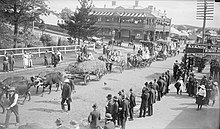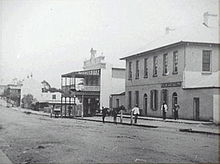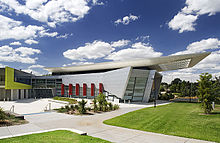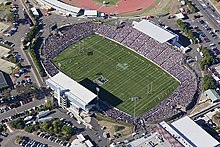| Campbelltown Sydney, New South Wales | |||||||||||||||
|---|---|---|---|---|---|---|---|---|---|---|---|---|---|---|---|
 Queen Street in Campbelltown c. 2005 Queen Street in Campbelltown c. 2005 | |||||||||||||||
| Population | 16,577 (SAL 2021) | ||||||||||||||
| Established | 1820 | ||||||||||||||
| Postcode(s) | 2560 | ||||||||||||||
| Elevation | 76 m (249 ft) | ||||||||||||||
| Location |
| ||||||||||||||
| LGA(s) | Campbelltown | ||||||||||||||
| Region | Greater Western Sydney Macarthur | ||||||||||||||
| State electorate(s) | Campbelltown | ||||||||||||||
| Federal division(s) | Macarthur | ||||||||||||||
| |||||||||||||||
Campbelltown is a suburb located on the outskirts of the metropolitan area of Sydney, New South Wales, Australia. It is located in Greater Western Sydney 53 kilometres (33 mi) south-west of the Sydney central business district by road. Campbelltown is the administrative seat of the local government area of the City of Campbelltown. It is also acknowledged on the register of the Geographical Names Board of New South Wales as one of only four cities within the Sydney metropolitan area.
Campbelltown gets its name from Elizabeth Campbell, the wife of former Governor of New South Wales Lachlan Macquarie. Originally called Campbell-Town, the name was later simplified to the current Campbelltown.
History
The area that later became Campbelltown was inhabited prior to European settlement by the Tharawal people. Not long after the arrival of the First Fleet in Sydney in 1788, a small herd of six cattle escaped and weren't seen again by the British settlers for seven years. They were spotted, however, by the Tharawal people. In a rock art site called Bull Cave near Campbelltown, they drew a number of cattle with pronounced horns. The Tharawal described the cattle to British explorers and in 1795 the British found a herd of around 60 cattle grazing in the area now known as Camden.
The colonial administration was keen for the herd to establish itself so forbade killing of the cattle or settlement in the area. But John Macarthur, who wanted to establish sheep in the colony, took a liking to the prime grazing land. He convinced the British government to overrule the local administration and grant him 5,000 acres (20 km) just south of the Nepean River in 1805. Four years later a number of other grants were made to farmers between Camden and Liverpool.
The Tharawal initially worked with the local farmers but a drought in 1814 led to large numbers of neighbouring Gandangara people moving into the area in search of food. Tensions developed between the British and the Gandangara leading to skirmishes and a number of deaths on each side. Governor Macquarie felt a permanent settlement would lead to order in the area and so Campbell-Town was born in 1820.
Town development

Development of the town was slow particularly after the departure of Macquarie, and it wasn't until 1831 that residents took possession of town land. However, it was during this period that Campbelltown's most famous incident occurred. In 1826, local farmer Frederick Fisher disappeared. According to folklore, his ghost appeared sitting on a fence rail over a creek just south of the town and pointed to a site where his body was later found to be buried. In memory of the incident, the Fisher's Ghost festival is held each November in Campbelltown.
Campbelltown's population increased steadily in the decades following. The southern rail line was extended to Campbelltown in 1858, leading to further development, and in 1882, Campbelltown Council was established allowing municipal works to occur in earnest. Campbelltown became the first country town in New South Wales to have piped water in 1888 and in the period between the World Wars, a local power station was built to supply electricity to residents.
After World War II, Campbelltown, having been previously a relatively small rural township, became a focal point for suburban expansion as part of Sydney's broader urban sprawl. The development of infrastructure and the availability of land in Campbelltown attracted families looking for affordable housing. New housing estates increased the significant population growth up until the 1970s.
Campbelltown was designated in the early 1960s as a satellite city by the New South Wales Planning Authority, and a regional capital for the south west of Sydney. There was extensive building and population growth in the intervening time and the government set aside land surrounding the township for public and private housing and industry.
Geography
Climate
Campbelltown has a humid subtropical climate (Köppen climate classification: Cfa) with mild to cool winters and warm to hot summers.
| Climate data for Campbelltown Swimming Centre, New South Wales, Australia (1962-1984 normals and extremes) | |||||||||||||
|---|---|---|---|---|---|---|---|---|---|---|---|---|---|
| Month | Jan | Feb | Mar | Apr | May | Jun | Jul | Aug | Sep | Oct | Nov | Dec | Year |
| Record high °C (°F) | 45.8 (114.4) |
43.0 (109.4) |
40.8 (105.4) |
33.9 (93.0) |
28.3 (82.9) |
25.6 (78.1) |
24.1 (75.4) |
29.0 (84.2) |
35.9 (96.6) |
36.8 (98.2) |
42.2 (108.0) |
41.0 (105.8) |
45.8 (114.4) |
| Mean daily maximum °C (°F) | 28.2 (82.8) |
28.4 (83.1) |
26.8 (80.2) |
24.1 (75.4) |
20.4 (68.7) |
17.6 (63.7) |
17.1 (62.8) |
18.7 (65.7) |
21.4 (70.5) |
23.5 (74.3) |
25.8 (78.4) |
27.9 (82.2) |
23.3 (74.0) |
| Daily mean °C (°F) | 22.5 (72.5) |
22.7 (72.9) |
20.9 (69.6) |
17.7 (63.9) |
14.0 (57.2) |
11.4 (52.5) |
10.2 (50.4) |
11.6 (52.9) |
14.2 (57.6) |
17.0 (62.6) |
19.2 (66.6) |
21.5 (70.7) |
16.9 (62.5) |
| Mean daily minimum °C (°F) | 16.7 (62.1) |
16.9 (62.4) |
15.0 (59.0) |
11.2 (52.2) |
7.6 (45.7) |
5.2 (41.4) |
3.2 (37.8) |
4.5 (40.1) |
7.0 (44.6) |
10.4 (50.7) |
12.6 (54.7) |
15.1 (59.2) |
10.5 (50.8) |
| Record low °C (°F) | 7.2 (45.0) |
6.1 (43.0) |
3.9 (39.0) |
0.0 (32.0) |
−0.6 (30.9) |
−2.0 (28.4) |
−5.6 (21.9) |
−2.5 (27.5) |
−0.6 (30.9) |
1.1 (34.0) |
2.9 (37.2) |
6.5 (43.7) |
−5.6 (21.9) |
| Average precipitation mm (inches) | 90.6 (3.57) |
78.6 (3.09) |
100.7 (3.96) |
62.6 (2.46) |
60.2 (2.37) |
81.6 (3.21) |
33.7 (1.33) |
50.4 (1.98) |
40.7 (1.60) |
74.3 (2.93) |
84.3 (3.32) |
70.5 (2.78) |
828.2 (32.6) |
| Average precipitation days (≥ 1 mm) | 8.3 | 8.1 | 8.1 | 5.5 | 5.6 | 6.4 | 4.3 | 5.6 | 5.9 | 8.4 | 7.3 | 6.4 | 79.9 |
| Source: | |||||||||||||
Commercial area

The old town centre, as laid down by Lachlan Macquarie, is still the main commercial area and includes the Queen Street shopping strip, Campbelltown Mall, Campbelltown railway station and bus interchange, the council chambers and a number of historic buildings. The main residential area is to the south and east of the town centre. On the northwestern side of the railway line is an industrial area.
To the southwest is a second commercial area based around Macarthur railway station which includes the University of Western Sydney and Macarthur Square, a large shopping mall. It features an outdoor entertainment and restaurant precinct known as "Kellicar Lane" which opened after an expansion in November 2005. It features a food court that has large glass windows that look over Kellicar Lane, Campbelltown and the surrounding countryside.
Heritage listings



Campbelltown has a number of heritage-listed sites on the New South Wales State Heritage Register, including:
- Broughton Street: St John's Catholic Church, Campbelltown
- 8 Lithgow Street: Glenalvon House
- 14 - 20 Queen Street: Warbys Barn and Stables
- 261 Queen Street: Campbelltown Post Office
- 263 Queen Street: Commercial Banking Company of Sydney, Campbelltown Branch (former)
- 284 - 298 Queen Street: Queen Street Buildings
- 303 Queen Street: Dredges Cottage
The following additional buildings in central Campbelltown are listed on the (now defunct) Register of the National Estate.
- St Peter's Church of England, Cordeaux Street
- Richmond Villa, 12 Lithgow Street
- Town Hall, 315 Queen Street
- Campbelltown Court House, Queen Street
- Campbelltown Police Station, Railway Street
- Graves of Matthew Healey, James Ruse, Cemetery, George and Broughton Streets
Transport

Campbelltown lies on the main road and rail links from Sydney to the south-west. The Hume Motorway links Campbelltown north to Liverpool, Sydney Airport and Sydney CBD and south to Melbourne. The B69 connects Wollongong CBD and Appin
Campbelltown railway station and Macarthur railway station are on the Sydney-Melbourne railway line. Campbelltown is also the northern terminus of most Southern Highlands Line intercity services. Campbelltown railway station was opened on 4 May 1858 with electrified services commencing on 5 May 1968.
Campbelltown is also well serviced by buses. Transit Systems provides a number of services from Campbelltown Station to virtually all the surrounding suburbs of Campbelltown as well as to Camden, and as far north as Liverpool via Glenfield. Picton Buslines provides a service from Campbelltown to Picton via Camden. There is also a bus service that connects Wollongong to Campbeltown.
Health

Campbelltown Hospital is part of the South Western Sydney Local Health District and is located on the southern edge of the suburb near Ambarvale. Campbelltown Private Hospital is located nearby and with the Centric building constitute a close-knit, combined public-private-consulting rooms complex within a convenient radius at Park Central.
Campbelltown Hospital is a major metropolitan hospital. Its emergency department is one of the busiest in Sydney, equipped with 32 beds and will expand further with the redevelopment of the hospital. The hospital has a wide range of surgical specialties, including general surgery (and its subspecialties of Breast & Endocrine surgery and Colorectal Surgery), orthopaedic surgery, ENT surgery, ophthalmology (i.e., eye surgery), etc. Breast cancers, thyroid and parathyroid diseases, as well as colonic and rectal cancers are particularly well served by the hospital, with its surgeons managing high volumes of these diseases at both Campbelltown public and private hospitals. The Macarthur Cancer Therapy Centre is a dedicated facility providing radiotherapy, chemotherapy and multidisciplinary cancer care to the local residents
Bed capacity is currently at 340 during peak times, with a planned addition of 90 beds with the current redevelopment (stage 1), bringing it up to 430 beds by the end of 2015. The new hospital block with an additional 90 beds is nearing completion with planning of the next major stage of redevelopment already underway (stage 2). It has a well-equipped intensive care (ICU) and high dependency unit (HDU) with the ability to support ventilated and critically ill patients. The hospital is well supported by a radiology department with services including ultrasounds, CT scans as well as a state-of-the-art MRI scanner
Education

The Western Sydney University (old name University of Western Sydney) has a Campbelltown Campus, located on Narellan Road. It was established from 1983 as the second campus of the Macarthur Institute of Higher Education, which merged into WSU in 1989. A TAFE NSW campus operates just opposite the Campbelltown campus of WSU.
There are a number of local schools, including:
- Campbelltown Performing Arts High School
- Broughton Anglican College
- Campbelltown Public School
- Campbelltown East Public School
- Campbelltown North Public School
- St Patricks College Campbelltown
- John Therry Catholic High School
- St John the Evangelist Catholic Primary
- St Peter's Anglican Primary
- Robert Townson High School
- Mount Carmel Catholic College
- Robert Townson Public School
- Kearns Public School
- Blairmount Public School
- Claymore Public School
- Eaglevale High School
- Leumeah Public School
- Leumeah High School
- Rosemeadow Public School
- Ambarvale High School
- Sarah Redfern High School
- Sarah Redfern Public School
- Minto Public School
- The Grange Public School
- Campbellfield Public School
- Al Faisal College
- St. Peter's Anglican Primary School (Campbelltown)
- Airds High School
- Woodland Road Public School
In the surrounding suburbs are a number of other schools associated with Campbelltown such as Broughton Anglican College, Mount Carmel High School (Varroville), Thomas Reddall High School (Ambarvale), Ambarvale High School (Rosemeadow), Menangle Park, and St Gregory's College, Campbelltown which is located in its own suburb, Gregory Hills.
Housing
The residential area has a combination of public and privately owned housing. Public housing estates are scattered across the region and the neighbouring areas.
Population
According to the 2021 census, there were 16,577 people in the suburb of Campbelltown, and 176,519 residents in the Campbelltown Local Government Area.
In the suburb of Campbelltown,
- Aboriginal and Torres Strait Islander people made up 4.5% of the population.
- 58.0% of people were born in Australia. The next most common countries of birth were India 3.5%, the Philippines 3.3%, New Zealand 2.9%, England 2.5% and Bangladesh 1.9%.
- 60.3% of people only spoke English at home. Other languages spoken at home included Arabic 3.4%, Bengali 2.4%, Nepali 1.8%, Urdu 1.7% and Tagalog 1.7%.
- The most common responses for religion were No Religion 24.3%, Catholic 22.2%, Anglican 10.9% and Islam 9.7%, a further 8.5% of respondents elected not to disclose their religion.
Notable residents
- Samantha Azzopardi – Con artist
- Mark Binskin – Former Chief of the Australian Defence Force
- Nicole Callisto – BMX cyclist; born in Joondalup, Western Australia, now resides in Campbelltown
- Tim Campbell – Former Home and Away actor and TV host
- Michael Carrington – Award-winning international media executive; resided in Campbelltown from birth to the age of 13
- Tallyn Da Silva – Australian rugby league footballer
- Paul Denyer – Serial killer
- Bronwyn Eagles – Six time women's hammer throw champion
- Nathan Foley – Former Hi-5 member
- Becca Hatch – Australian R&B singer
- Jarryd Hayne – Australian rugby league, rugby union and gridiron footballer athlete
- Brett Hodgson – Former Wests Tigers captain and current head coach of the Western Suburbs Magpies
- Trent Hodkinson – Australian rugby league footballer
- Ryan Hoffman – Australian rugby league footballer
- Mark Hunt – New Zealand mixed martial arts fighter
- Krisnan Inu – New Zealand rugby league footballer
- Alanna Kennedy – Footballer for The Matildas, Manchester City and Sydney FC
- Emcee Kerser – Australian rapper
- Joseph Leary – Former Australian solicitor, politician and Member of the Lower House.
- Peter Fitzallan MacDonald – Australian pastoralist, entrepreneur and politician.
- John Marsden – Lawyer, appointed Member of the Order of Australia
- Trent Peoples – Australian rugby league footballer
- Jim Piper – Australian breaststroke swimmer
- Bruce Quick – Olympic shooter
- Kate Ritchie – Australian actress and Gold Logie winner
- James Ruse – Early settler and farmer; Ruse, New South Wales named after him
- Yvonne Strahovski – Star of US TV series Chuck and The Handmaid's Tale
- Jai Waetford – X Factor finalist
- Lisa Wilkinson – The Project co-host on the Network 10
- William Hardy Wilson – Architect, artist and author; regarded as "one of the most outstanding architects of the twentieth century"
Culture
The Arts

The Campbelltown Arts Centre, situated just south of the main town centre features a 180-seat performance space, exhibition galleries and workspaces. Outside is a sculpture garden and a Japanese Gardens and Teahouse that was a gift from Campbelltown's sister city Koshigaya in Japan.
Fisher's Ghost Festival
The Fisher's Ghost Festival is an annual festival held in recognition of Frederick Fisher, an emancipated convict who owned farming land in Campbelltown. Legend has it that Fisher appeared to local man John Farley as a ghost after being murdered by George Worrall, his friend and neighbour, over a land dispute. An annual parade through Campbelltown's main street, Queen Street, is held each November, and a carnival including fairground rides and other entertainment is held at Bradbury Oval, a local sports ground. Over a period of two weeks many activities take place, including the Fisher's Ghost Fun Run, the Fisher's Ghost Art Award and the Street Party which was formerly known as the Mardi Gras.
Media
Campbelltown is home to two local radio stations, 2MCR and C91.3FM. The two local newspapers are the Campbelltown-Macarthur Advertiser and the Macarthur Chronicle.

Sport and recreation
Campbelltown is very well known for its strong sporting culture. This includes Rugby League, Cricket, Athletics, Soccer and Australian Rules Football. Campbelltown has produced many professional athletes who have represented Australia at Olympic level. Its leading sporting team is the Wests Tigers who play in the National Rugby League competition. The Wests Tigers are a merger of two foundation clubs of the old New South Wales Rugby League premiership, the Western Suburbs Magpies and the Balmain Tigers. As such, they play some of their home games at Campbelltown Stadium in neighbouring Leumeah and others at Leichhardt Oval in inner-western Sydney. The Magpies still exist as a stand-alone team in the lower-tier competition, the New South Wales Cup, and play home games at Campbelltown Stadium.
Macarthur FC played their first season in the A-League Men in late 2020, after they were awarded a license under the name "Macarthur South-West Sydney" in December 2018 as part of the league's expansion. The club will play their home games at Campbelltown Stadium.
Another tenant of Campbelltown Stadium is the Macarthur Rams soccer team which plays in the New South Wales Premier League competition. Campbelltown is represented in the Sydney Grade Cricket competition by the Campbelltown-Camden Ghosts who play their home games in Raby and in the Sydney AFL's Premier Division, by the Campbelltown Blues who play their home games in Macquarie Fields. The Campbelltown District Netball Association, based in Minto, plays in the third division of the Netball NSW State League.
Campbelltown Billabong Parklands, a large 4 hectare recreation area with outdoor swimming pools and parkland, opened in 2024 at Apex Park.
References
- Australian Bureau of Statistics (28 June 2022). "Campbelltown (NSW) (suburb and locality)". Australian Census 2021 QuickStats. Retrieved 28 June 2022.

- "Geographical Names Register Extract: List of placenames acknowledged as a CITY". Geographical Names Register (GNR) of NSW. Geographical Names Board of New South Wales. Archived from the original (.CSV) on 12 October 2016. Retrieved 31 August 2008.
- "Panoramio is no longer available". Panoramio.com. Archived from the original on 21 August 2017. Retrieved 2 October 2018.
- ^ "History of Campbelltown". Campbelltown City Council. Archived from the original on 30 July 2008. Retrieved 14 March 2008.
- Listo, C: Campbelltown: The Bicentennial History, Allen & Unwin, 1988: pp. 1–4. ISBN 0-04-324015-1
- "History of the Macarthur Region". Campbelltown City Council. Archived from the original on 19 July 2008. Retrieved 14 March 2008.
- Liston, C: Campbelltown: The Bicentennial History, Allen & Unwin, 1988: pp. 5–8. ISBN 0-04-324015-1.
- Liston, C: Campbelltown: The Bicentennial History, Allen & Unwin, 1988: pp. 10–23. ISBN 0-04-324015-1.
- "Campbelltown". The Sydney Morning Herald. 8 February 2004. Retrieved 14 March 2008.
- The Book of Sydney Suburbs, Frances Pollon, Angus & Robertson Publishers, 1990, p. 45, ISBN 0-207-14495-8.
- "Climate statistics for Campbelltown". Bureau of Meteorology. Retrieved 26 April 2022.
- "St. Johns Roman Catholic Church and Cemetery (former)". New South Wales State Heritage Register. Department of Planning & Environment. H00193. Retrieved 18 May 2018.
 Text is licensed by State of New South Wales (Department of Planning and Environment) under CC BY 4.0 licence.
Text is licensed by State of New South Wales (Department of Planning and Environment) under CC BY 4.0 licence.
- "Glenalvon". New South Wales State Heritage Register. Department of Planning & Environment. H00004. Retrieved 18 May 2018.
 Text is licensed by State of New South Wales (Department of Planning and Environment) under CC BY 4.0 licence.
Text is licensed by State of New South Wales (Department of Planning and Environment) under CC BY 4.0 licence.
- "Warbys Barn & Warbys Stables". New South Wales State Heritage Register. Department of Planning & Environment. H00497. Retrieved 18 May 2018.
 Text is licensed by State of New South Wales (Department of Planning and Environment) under CC BY 4.0 licence.
Text is licensed by State of New South Wales (Department of Planning and Environment) under CC BY 4.0 licence.
- "Campbelltown Post Office (former)". New South Wales State Heritage Register. Department of Planning & Environment. H00265. Retrieved 18 May 2018.
 Text is licensed by State of New South Wales (Department of Planning and Environment) under CC BY 4.0 licence.
Text is licensed by State of New South Wales (Department of Planning and Environment) under CC BY 4.0 licence.
- "CBC Bank". New South Wales State Heritage Register. Department of Planning & Environment. H00499. Retrieved 18 May 2018.
 Text is licensed by State of New South Wales (Department of Planning and Environment) under CC BY 4.0 licence.
Text is licensed by State of New South Wales (Department of Planning and Environment) under CC BY 4.0 licence.
- "Queen Street Buildings Group". New South Wales State Heritage Register. Department of Planning & Environment. H00007. Retrieved 18 May 2018.
 Text is licensed by State of New South Wales (Department of Planning and Environment) under CC BY 4.0 licence.
Text is licensed by State of New South Wales (Department of Planning and Environment) under CC BY 4.0 licence.
- "Dredges Cottage". New South Wales State Heritage Register. Department of Planning & Environment. H00640. Retrieved 18 May 2018.
 Text is licensed by State of New South Wales (Department of Planning and Environment) under CC BY 4.0 licence.
Text is licensed by State of New South Wales (Department of Planning and Environment) under CC BY 4.0 licence.
- The Heritage of Australia, Macmillan Company, 1981, p. 2/19.
- "Macarthur Bus Network Map" (PDF). Busways. Retrieved 16 April 2008.
- "870 timetable" (PDF). Interline. Archived from the original (PDF) on 18 July 2008. Retrieved 16 April 2008.
- "Picton District Map" (PDF). Picton Buslines. Archived from the original (PDF) on 19 July 2008. Retrieved 16 April 2008.
- "4 Hyde Parade, Campbelltown, NSW". Archived from the original on 20 March 2012. Retrieved 10 September 2012.
- "Campbelltown Hospital Redevelopment". Archived from the original on 20 October 2013. Retrieved 10 September 2012.
- "Fight against breast cancer stepped up". 3 March 2015. Archived from the original on 4 December 2020. Retrieved 12 June 2015.
- http://www.sswahs.nsw.gov.au/sswahs/cancer/location.html Archived 30 March 2011 at the Wayback Machine
- "Roxon announces MRI for Campbelltown". ABC News. 22 July 2010.
- ^ Australian Bureau of Statistics (28 June 2022). "Campbelltown (NSW)". 2021 Census QuickStats. Retrieved 20 May 2024.

- Australian Bureau of Statistics (28 June 2022). "Campbelltown (NSW)". 2021 Census QuickStats. Retrieved 20 May 2024.

- "Meet the 19-year-old from Western Sydney making world class R&B". Australian Broadcasting Corporation. Triple J. 23 March 2020. Retrieved 14 May 2024.
- "Art and Culture". Campbelltown City Council. Archived from the original on 1 July 2009. Retrieved 23 May 2009.
- "Festival info". Campbelltown City Council. Archived from the original on 2 May 2009. Retrieved 23 May 2009.
- "Local Media". Campbelltown City Council. Archived from the original on 1 July 2009. Retrieved 23 May 2009.
- "Two teams to join expanded A-League". A-League. 14 December 2018.
- "Macarthur District Soccer Football Association". Macarthur District Soccer Football Association. Archived from the original on 18 March 2008. Retrieved 6 April 2008.
- "Campbelltown-Camden Ghosts". NSW Cricket. Archived from the original on 25 March 2008. Retrieved 6 April 2008.
- "Campbelltown Blues". Sydney AFL. Retrieved 16 August 2012.
- "State League Div 3". Netball NSW. Archived from the original on 14 July 2011. Retrieved 6 April 2008.
- "Campbelltown District Netball Association". Campbelltown District Netball Association. Retrieved 6 April 2008.
- "Campbelltown Billabong Parklands". www.campbelltown.nsw.gov.au. Retrieved 9 January 2025.
External links
34°4′S 150°49′E / 34.067°S 150.817°E / -34.067; 150.817
- Campbelltown City Council website
- Australian Bureau of Statistics (9 March 2006). "Campbelltown". 2001 Census QuickStats.

- Australian Bureau of Statistics (25 October 2007). "Campbelltown". 2006 Census QuickStats.